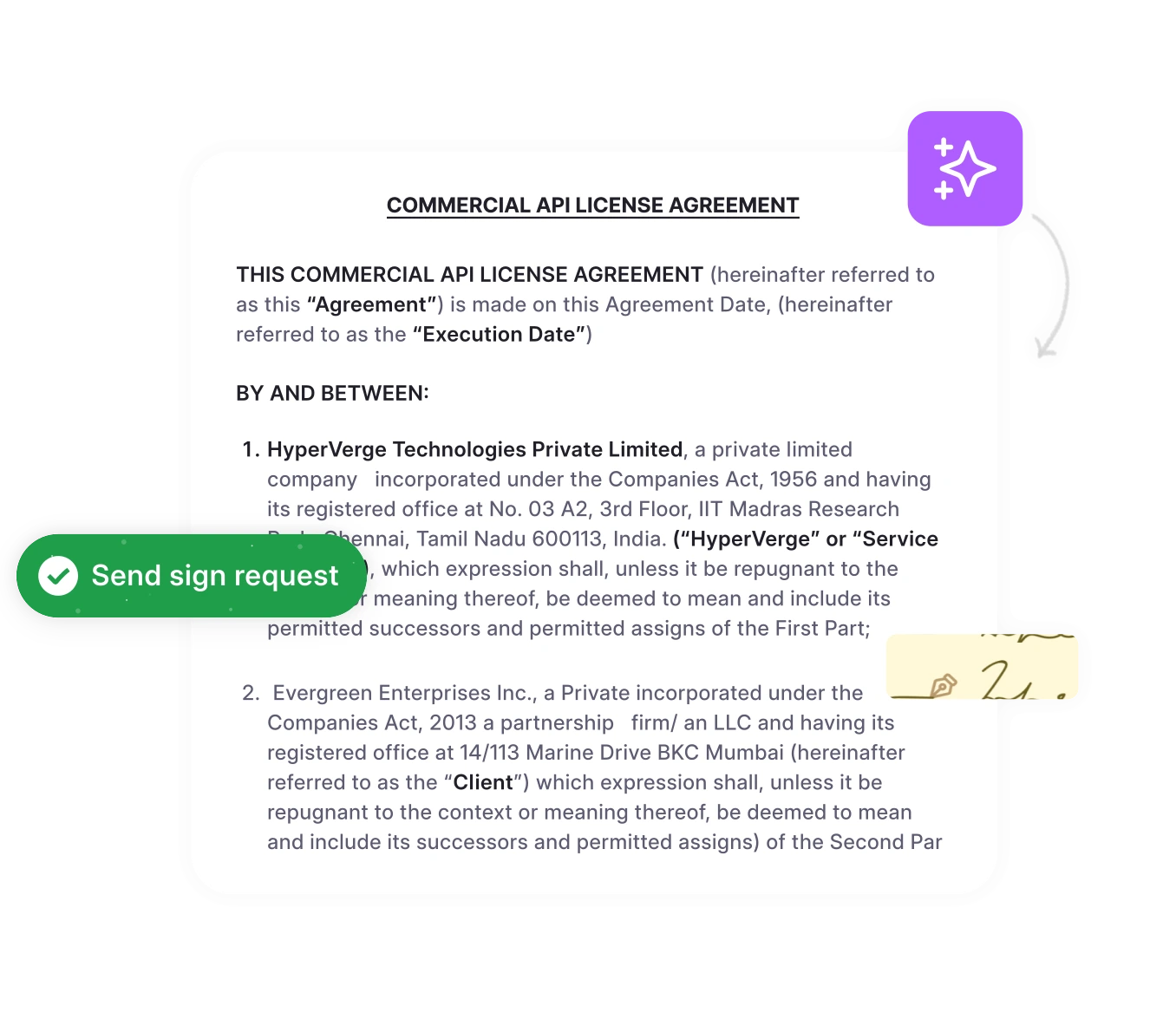The legal document forms the foundation of every formal business interaction—whether it’s closing a deal, launching a partnership, managing contract compliance, or protecting intellectual property. These documents not only define the terms of engagement but also safeguard the interests of all parties involved.
Despite their importance, re-inventing the wheel to draft, organize, and manage them every time is not the best use of billable hours or legal fees. Inconsistency in intake, ambiguities in language, lack of standardization, and scattered storage systems often lead to confusion, delays, and costly legal exposure
This guide offers a clear roadmap to understand what legal documents are, why they matter, and how to create them effectively. We’ll walk you through their key components, common types used in business, best practices for drafting, and the critical mistakes to avoid.
What is a legal document?
A legal document is a written instrument that records and formalizes an agreement, obligation, or other legally enforceable act. Unlike regular documents, legal documents create binding relationships that can be enforced through courts and carry significant legal consequences when violated.
Key characteristics of legal documents
- Legally binding nature- Creates enforceable rights and obligations
- Formal structure- Follows specific legal formatting and language requirements
- Mutual assent- Requires agreement from all parties involved
- Legal standing- Can be used as evidence in court proceedings
- Compliance requirements- Must adhere to applicable laws and regulations
Legal document vs. regular document: understanding the distinction
| Aspect | Legal Document | Regular Document |
| Core Definition | Creates binding legal relationships and obligations. | Serves informational or operational purposes without legal enforceability. |
| Enforceability | Legally enforceable in court. | Not legally enforceable. |
| Purpose | Establishes rights, duties, and responsibilities between parties. | Shares updates, records meetings, or documents internal processes. |
| Examples | Contracts, service agreements, NDAs, wills. | Emails, memos, meeting notes, project proposals (pre-signature). |
| Transformation Point | Becomes binding once signed with terms, conditions, and obligations. | Remains non-binding unless converted into a formal agreement. |
Knowing the definition is just the first step—next, it’s important to break down the key components that make a legal document clear, enforceable, and reliable.
What are the core components of effective legal documents?
Understanding the essential elements that make contracts and legal documents legally sound is crucial for businesses of all sizes. Every effective legal document should include these fundamental components:
1. Essential legal elements
- Offer and Acceptance: Clear presentation of terms by one party and unambiguous acceptance by another. This establishes the foundation of the legal relationship.
- Consideration: Something of value exchanged between parties- whether money, services, goods, or promises. Without consideration, most agreements lack legal enforceability.
- Legal Capacity: All parties must have the legal authority to agree. This includes being of legal age, mentally competent, and contractual capacity.
- Mutual Assent: All parties must understand and agree to the same terms. Ambiguous language or misunderstandings can invalidate agreements.
- Legality: The document’s purpose and terms must comply with applicable laws. Illegal agreements are generally unenforceable.
Read A Complete Guide to Contract Law Essentials
2. Structural components
- Preamble: Identifies the parties, establishes context, and states the document’s purpose. This section sets the foundation for the entire agreement.
- Definitions: Clarifies specific terms used throughout the document to prevent misinterpretation and ensure consistent understanding.
- Terms and Conditions: The substantive provisions outlining each party’s rights, obligations, and responsibilities.
- Performance Standards: Specific criteria for fulfilling obligations, including timelines, quality standards, and deliverable specifications.
- Dispute Resolution Mechanisms: Procedures for handling disagreements, including mediation, arbitration, or litigation processes.
- Signature Section: Formal execution area with dates, ensuring proper authorization and creating the binding agreement.
Eliminate guesswork from legal documents
HyperStart highlights risk-prone areas and suggests contextual fixes so your team can move faster with confidence.
Book a DemoOnce you understand what goes into an effective legal document, the next step is to explore the different types used across various business functions and transactions.
What are the different types of legal contracts in business?
Legal documents serve diverse purposes across different business functions. Understanding the various categories helps organizations identify their needs and ensure comprehensive coverage.
| Document Type | Category | Key Purpose |
| Service Agreements | Contractual | Define scope, deliverables, and compensation for professional services |
| Employment Contracts | Contractual | Outline roles, compensation, benefits, and employment terms |
| Sales Contracts | Contractual | Formalize the exchange of goods/services with delivery and payment terms |
| Partnership Agreements | Contractual | Establish profit sharing, authority, and operational frameworks |
| Non-Disclosure Agreements | Contractual | Protect confidential information and trade secrets |
| Privacy Policies | Compliance | Explain data collection, use, and protection practices |
| Terms of Service | Compliance | Govern business-customer relationships and platform usage |
| Loan Agreements | Financial | Detail borrowing terms, repayment, and collateral requirements |
| Shareholder Agreements | Corporate | Define shareholder rights, voting, and profit distribution |
| Patents | IP Protection | Grant exclusive rights to inventions and innovations |
| Trademarks | IP Protection | Protect brand names, logos, and identifying marks |
| Copyrights | IP Protection | Secure rights to original creative works and content |
Also read Legal Contract Management for In-House Counsel
Beyond their formats and categories, legal documents serve a broader purpose in today’s business environment—let’s explore the strategic role they play in operations, governance, and risk management.
The critical role of legal documents in modern business
Legal documents serve as the backbone of business operations, providing structure, protection, and clarity in an increasingly complex commercial environment. Their importance extends far beyond mere legal compliance.
1. Risk management and protection
Legal documents create protective barriers around business interests. Well-drafted agreements define responsibilities, limit liabilities, and provide recourse when things go wrong. They transform verbal understandings into enforceable commitments, reducing uncertainty and potential conflicts.
Risk mitigation strategies include:
- Clearly defined performance standards and deadlines
- Limitation of liability clauses protecting against excessive damages
- Indemnification provisions shifting certain risks between parties
- Force majeure clauses addressing unforeseeable circumstances
- Termination clauses provide exit strategies when relationships deteriorate
2. Operational efficiency and clarity
Comprehensive legal documents eliminate ambiguity in business relationships. They provide roadmaps for performance, establish communication protocols, and create accountability frameworks that keep projects and partnerships on track.
3. Competitive advantage
Strategic use of legal documents can create competitive advantages through exclusive partnerships, protected intellectual property, and optimized vendor relationships. They enable businesses to secure favorable terms, protect innovations, and build sustainable competitive moats.
4. Financial protection
Legal documents directly impact bottom-line results by preventing revenue leakage, ensuring timely payments, and providing legal recourse for contract breaches. They establish clear payment terms, late fees, and collection procedures that protect cash flow.
Simplify legal document review
Use HyperStart’s contextual AI to surface vague, outdated, or high-risk language—before it impacts your deal flow.
Book a DemoTo ensure your legal documents serve their intended purpose and remain enforceable, you need to follow proven best practices during their creation and review.
What are the best practices for creating legal documents?
Creating effective legal documents requires balancing legal rigor with practical business needs. These 5 best practices help ensure documents serve their intended purpose while minimizing risks.
1. Start with strategic planning and thorough preparation
Before putting pen to paper, define exactly what your document needs to accomplish and who it affects. Research applicable laws and regulations early to avoid costly revisions later. Gather all necessary details about parties, obligations, timelines, and performance standards upfront. This foundation work prevents scope creep and ensures your document addresses every critical aspect from the start.
2. Prioritize clarity and logical organization
Legal documents shouldn’t require a law degree to understand. Use clear, specific language that eliminates ambiguity, and organize content with numbered sections and logical flow. Create comprehensive definitions for technical terms, and establish measurable performance standards with specific timelines and quality criteria. When stakeholders can easily find and understand information, disputes decrease significantly.
3. Implement robust review and validation processes
A single overlooked clause can create expensive problems down the road. Establish multi-stage legal document review processes involving legal, business, and technical stakeholders to catch issues before execution. Test document clarity with actual users, not just lawyers, and validate contract compliance through expert consultation. Maintain strict version control to ensure everyone works from the same document throughout the process.
4. Focus on enforceability and practical implementation
The best legal document is one that actually gets used correctly. Design documents with real-world implementation in mind, including clear performance benchmarks, realistic timelines, and practical dispute resolution mechanisms. Consider how the document will be monitored and enforced throughout its lifecycle, building in checkpoints and reporting requirements that make compliance manageable.
5. Leverage technology for consistency and efficiency
Customized legal documents benefit enormously from clause libraries, and automated workflows. Use a CLM software to ensure consistent language across similar document types, implement approval routing that prevents bottlenecks, and establish automated tracking for key obligations and deadlines. This approach reduces human error while speeding up the entire document creation process.
CLM software adoption is rapidly increasing as businesses replace manual contract management with AI-powered, cloud-based solutions. The market, valued at USD 2.89 billion in 2025, is projected to grow to USD 6.81 billion by 2032 at a 13% CAGR, driving faster workflows, fewer errors, and stronger compliance.
Even with best practices in place, mistakes still happen. Let’s identify the most common legal document pitfalls—and how you can proactively avoid them.
Common legal document mistakes and how to avoid them
Even well-intentioned organizations make critical errors that can invalidate documents or create unintended liabilities.
Understanding these 5 common pitfalls helps businesses protect their interests.
1. Ambiguous language and terms
The Problem: Vague language like “reasonable efforts” or “industry standard” creates interpretation disputes that can lead to costly litigation.
The Solution: Define all subjective terms clearly within the document. Replace vague language with specific, measurable criteria that leave no room for misinterpretation.
Read Contract Drafting Guide: Steps, Best Practices & Tools
2. Missing essential elements
The Problem: Erratic intake processes, documents lacking proper consideration, mutual assent, or legal capacity may be unenforceable despite good intentions from two or more parties.
The Solution: Benchmark legal forms with simple questions and contract checklists to ensure all legal elements are present and properly documented before drafting.
Agreement template
Paper source
Agreement date
Counterparty name
Counterparty signer name
Counterparty signer email
Internal party signer name
Internal party signer email
3. Inadequate performance standards
The Problem: Unclear deliverables, undefined timelines, and subjective quality standards create performance disputes and relationship conflicts.
The Solution: Establish specific, measurable performance criteria with clear consequences for non-compliance and well-defined acceptance procedures.
Only 40% of firms conduct daily compliance checks, yet those that adopt continuous compliance see reductions in fraud, faster onboarding, and operational savings, highlighting how legal and risk management must evolve beyond intermittent checks to sustain protections.
4. Poor document management
The Problem: Lost documents, unclear version control, and inadequate storage create legal vulnerabilities and operational inefficiencies.
The Solution: Implement centralized document management systems with version control, access permissions, and comprehensive audit trails.
5. Ignoring regulatory changes
The Problem: Legal documents may become non-compliant when laws change, creating unexpected liabilities and enforcement issues.
The Solution: Establish regular review cycles to assess regulatory compliance and update documents proactively.
Turn legal documents into a strategic advantage
Move beyond manual reviews—automate clause analysis and protect your terms at every step with HyperStart.
Book a DemoThe legal document as a strategic asset
Legal documents are no longer just compliance checkboxes; they’re critical business tools that, when properly managed, can safeguard interests, unlock efficiencies, and support long-term growth. Organizations that modernize their approach to document management gain a distinct advantage in today’s high-stakes business environment.
With HyperStart, businesses can move beyond fragmented, manual processes and adopt AI-powered contract lifecycle management that delivers real-time visibility, reduces risk, and accelerates workflows. This transformation isn’t just technological—it’s strategic.











